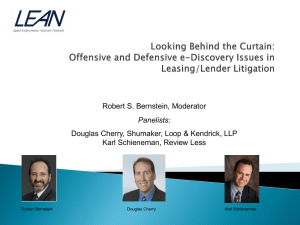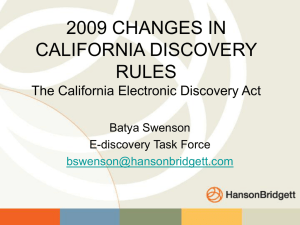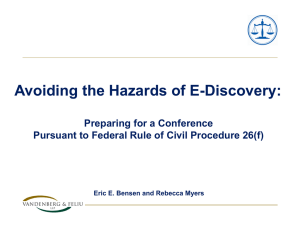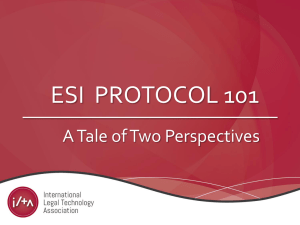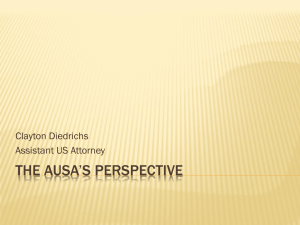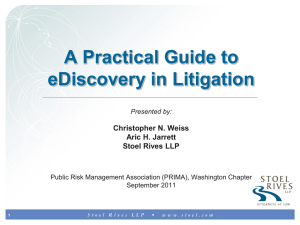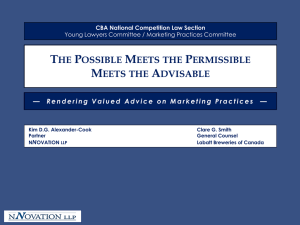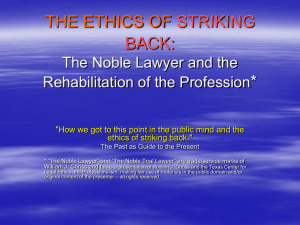Ethics and E-discovery: Where the Rubber Meets the
advertisement
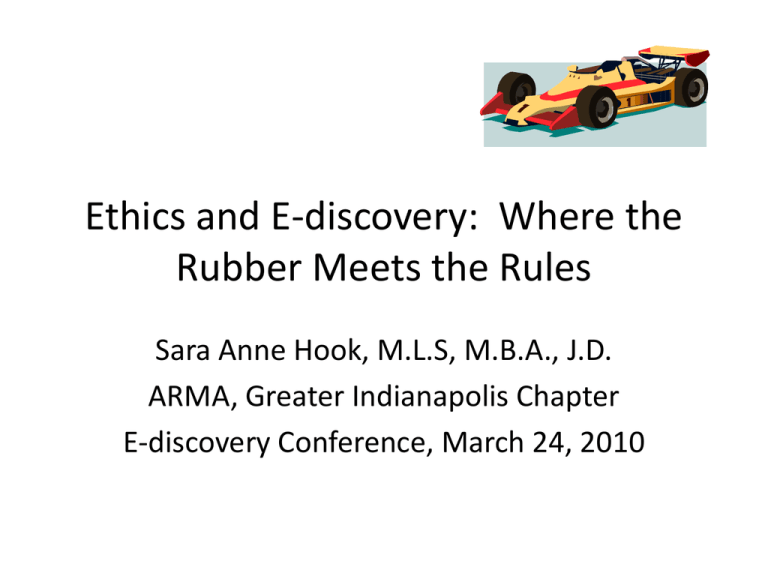
Ethics and E-discovery: Where the Rubber Meets the Rules Sara Anne Hook, M.L.S, M.B.A., J.D. ARMA, Greater Indianapolis Chapter E-discovery Conference, March 24, 2010 Synopsis • This engaging session will consider the ethical obligations of attorneys in electronic discovery. • The field of electronic discovery is still in its infancy and we may believe that there is little to help us navigate the ever-changing landscape of court decisions, procedural requirements and technological tools. • Fortunately, we can use the Model Rules of Professional Conduct as a roadmap to chart a safe course from the starting point of a case to the end of the litigation journey. • Recent cases also illuminate the potholes, detours, dead ends and hazards along the way so that we can be responsible drivers throughout all phases of an electronic discovery process. • The field of e-discovery is in its infancy, so attorneys must stay aware of the latest court decisions, ethical opinions, trial rules and technological developments. About the Presenter • Sara Anne Hook is Professor of Informatics and Associate Dean for Academic Affairs, IU School of Informatics, IUPUI, where she has developed a suite of courses in the emerging field of legal informatics. • She is also Adjunct Professor of Law in the Indiana University School of Law - Indianapolis, where she teaches courses in intellectual property law and professional responsibility. • Professor Hook’s research interests include intellectual property law, the emerging field of legal informatics, electronic discovery, legal technology, legal research techniques and issues related to privacy and security. • Professor Hook is a member of the American Intellectual Property Law Association (AIPLA), the Indiana State Bar Association, the International Legal Technology Association (ILTA) and the American Association for State and Local History (AASLH). Why Does E-Discovery Create Ethical Issues? • More people generating and saving more information at all stages of a matter, rather than a single archived paper file of final signed documents and memoranda • Over 99 percent of information now in digital form – nearly 70 percent may never be reduced to paper (hard copy) form • Information now created in a variety of formats: word processing, spreadsheets, databases, text messages, digital images, audio, video, websites, social networking, tweets, faxes, YouTube, etc. now known as Electronically Stored Information (ESI) • All of this ESI is stored on a multitude of devices, including desktop computers, laptops, mobile devices, flash drives, voicemail, email, printers, scanners, copiers, CDs, DVDs AND on an employee’s home computer and personal devices • Significant sanctions – for clients and for attorneys • Technology-savvy judges Why Does E-Discovery Create Ethical Issues? • Metadata = danger! • Deleted data – or is it? • Inadvertent production (privilege) – speed of discovery process and massive amount of ESI to be produced and reviewed • Inadvertent destruction of ESI • Back-up tapes – are they “inaccessible? • Identifying the key players in litigation • Forms of production – native v. image • Third-party vendors in the context of e-discovery • New responsibilities for attorneys – Zubulake v. UBS Warburg, revisions to the Federal Rules of Civil Procedure and various state trial rules Attorney Competence in the Context of Electronic Discovery • Model Rule (Indiana Rule) 1.1: A lawyer shall provide competent representation to a client. Competent representation requires the legal knowledge, skill, thoroughness and preparation necessary for the representation. • Comment 6: To maintain the requisite knowledge and skill, a lawyer should keep abreast of changes in the law and its practice, engage in continuing study and education and comply with all continuing legal education requirements to which the lawyer is subject. • So failure to be informed about – and comply with – all requirements of e-discovery will not be an excuse • May be useful (especially for smaller firms) to work with a thirdparty e-discovery vendor – BUT: the attorney will still be under a duty to supervise under Model Rule 5.3(c). In other words, hiring a vendor will not avoid or erase any ethical duties of the lawyer. Duty of Confidentiality • Model Rule 1.6 (also Indiana Rule 1.6) (a): A lawyer shall not reveal information relating to the representation of a client unless the client gives informed consent, the disclosure is impliedly authorized in order to carry out the representation or the disclosure is permitted by paragraph (b) - (preventing death, substantial bodily injury, etc.) • Comment [16] states that a lawyer must act competently to safeguard information relating to the representation of a client against inadvertent or unauthorized disclosure by the lawyer or other persons who are participating in the representation of the client or who are subject to the lawyer’s supervision. • Care needed when sending email, especially with Reply To, Reply To All, automatic filling in of email addresses, fax machines • Metadata in edited documents – or documents that have been “repurposed” Inadvertent Production of Privileged Information • • • • • • ESI protected by attorney-client privilege ESI protected as attorney work product Other confidential information Clawback agreements Restrictions on use by opposing counsel Special danger in e-discovery context – sheer volume of ESI and short window of time to produce it to the opposing party • Fortunately, technology is getting better – allows keyword (person, date, event) searching to reduce the set of potentially relevant ESI that needs a live human to review prior to production • Statistics suggests that we can perhaps reduce the set of ESI needing live human review by 75% using technology tools Mistake Discovered by Receiving Party • But: careless production and review process will not prevent waiver of privilege • Model Rule 4.4(b): A lawyer who receives a document relating to the representation of the lawyer’s client and who knows or reasonably should know that the document was inadvertently sent shall promptly notify the sender. (Also Indiana Rule 4.4(b)) • Per Comment [2], note that this applies to any documents that were mistakenly sent or produced by opposing lawyers or their lawyers (in other words, not just privileged documents). Note that Comment [2] in the Indiana Rules states that “document” includes email or other electronic modes of transmission subject to being read or put into readable form. • See also revision to Federal Rules of Evidence – FRE Rule 502 on limitations on waivers of attorney-client privilege and work product Mistake Discovered by Producing Party • FRCP 26(b)(5)(B): If information produced in discovery is subject to a claim of privilege or of protection as trial preparation material, the party making the claim may notify any party that received the information of the claim and the basis for it. After being notified, a party must promptly return, sequester, or destroy the specified information and any copies of it; must not use or disclose the information until the claim is resolved; must take reasonable steps to retrieve the information if the party disclosed it before being notified; and may promptly present the information to the court under seal for a determining of the claim. The producing party must preserve the information until the claim is resolved. • See also Indiana Rules of Trial Practice 26(B)(5) • Also waiver and process for handling inadvertently produced ESI should be discussed in a “meet and confer” conference. Mining for Metadata • Metadata is a clear danger: client confidentiality • Metadata can be generated just by using computer software (word processing) without the user even being aware of it • Or metadata can be generated because of user’s settings • Examples: Revisions, authors, track changes • Can “un-erase” changes to reveal confidential or other valuable information • Are image formats safe? Some people recommend printing the document, blacking out the information and rescanning the document just to make sure that the information is truly “gone” • Divergence of opinions on the ethics of mining for metadata – when inadvertently produced • See Metadata Comparison Chart from the ABA http://www.abanet.org/tech/ltrc/fyidocs/metadatachart.html Preservation and Production of Electronically Stored Information (ESI) • Revisions to the Federal Rules of Civil Procedure added the term Electronically Stored Information (ESI) – an updated term from “data or data compilations” and designed to encompass a wide range of known and future formats for information (including text, images, sound, etc.) • Parties should work together at the outset of litigation to agree option the format(s) for ESI – native v. image files, metadata intact, searchable – part of mandatory “meet and confer” conference in federal courts • The burden is on the requesting party to specify the preferred format – generally, courts will not allow a second request in another format • If not specifically requested, the default under FRCP Rule 34(b)(ii) (Indiana Rule 34(B) is that the responding party can produce ESI in the format at which it is ordinarily maintained or in a reasonably usable format. • Ethical issues: not thinking this through before making the request, then not being able to do what you need to do with the information. For example: financial statements – in image format OR as a spreadsheet, so that you can search, check formulas and calculations, look for hidden cells. Establishing Records Retention Policies for Clients • Clients need a records retention policy that makes sense – and then to ensure compliance with the policy (instead of “remembering” it in anticipation of litigation) • “Defensible document retention requires the development, implementation and continued monitoring of a thorough and thoughtful electronic document retention policy that is tailored to an organization’s particular needs.” • Reduces expenses: no need to keep ESI that is no longer needed • Reduces risks – outdated information and multiple copies are eliminated • Excellent kinds of technology available for archiving • In order to qualify for “safe harbor” provision per FRCP Rule 37(e): Prevents courts from imposing sanctions on a party for failing to provide ESI lost as a result of the routine, good faith operation of an electronic information system. Monitoring Client Compliance • The Zubulake v. UBS Warburg case outlined some ongoing responsibilities of lawyers during the e-discovery process. • A party’s discovery obligations do not end with the implementation of a “litigation hold” to the contrary, that’s only the beginning. • Counsel must oversee compliance with the litigation hold, monitoring the party’s efforts to retain and produce the relevant documents. • Proper communication between a party and her lawyer will ensure (1) that all relevant information (or at least all sources of relevant information) is discovered, (2) that relevant information is retained on a continuing basis; and (3) that relevant non-privileged material is produced to the opposing party. Monitoring Client Compliance • First, counsel must issue a "litigation hold" at the outset of litigation or whenever litigation is reasonably anticipated. The litigation hold should be periodically re-issued so that new employees are aware of it, and so that it is fresh in the minds of all employees. • Second, counsel should communicate directly with the "key players" in the litigation, i.e., the people identified in a party's initial disclosure and any subsequent supplementation thereto . . . . • Finally, counsel should instruct all employees to produce electronic copies of their relevant active files. Counsel must also make sure that all backup media which the party is required to retain is identified and stored in a safe place. • Also important to be aware of the “safe harbor” provision in FRCP Rule 37(e) – and Indiana Rule of Trial Procedure 37(E) • Litigation hold: “whenever litigation is reasonably anticipated” Duty to Supervise: Within the Law Firm • Model Rule 5.1 (also Indiana Rule) – responsibilities of partners – must make reasonable efforts to be sure that all lawyers under his/her supervision are in compliance with Rules of Professional Conduct - and bears responsibility when there are violations by the attorneys being supervised • Model Rule 5.2 (also Indiana Rule) – responsibilities of subordinate lawyers – specific situations when you cannot ignore ethical duties in deference to a supervising attorney or partner’s decision - must be a reasonable resolution of an arguable question of professional duty • Model 5.3 (also Indiana Rule) – responsibilities regarding nonlawyer assistants – not good enough to say “that was my secretary’s mistake” • Bottom line: the buck stops with the senior attorney or lead attorney on the case Duty to Supervise: When Outsourcing Electronic Discovery Processes • Model 5.3 (also Indiana Rule) – responsibilities regarding nonlawyer assistants • Also applies to third-party vendors • Cannot avoid violations of the Rules by “hiring away” the ethical breaches. • Lawyer has ultimate responsibility for the integrity of the ediscovery process • Attorneys, clients and vendors must understand the roles in the ediscovery process • Vendor should not assume the role of a legal advisor – beware of UPL – Indiana taking robust steps to address UPL violations, including a bill being considered that would include UPL under RICO and thus make it a felony as opposed to a misdemeanor • Special care needed with privileged information Dealing with Third-Party Vendors: ABA Formal Opinion 08-451 • The lawyer could conduct background checks of any lawyer, nonlawyer or placement agency involved • Interview the lawyers involved, and assess their educational background; • When working with an intermediary, inquire into its hiring practices so as to ascertain the character of the employees who are likely to have access to client information; • Investigate the security measures in effect in the provider’s premises, including its computer network and refuse disposal systems; • Depending on the circumstances, it may be prudent to conduct a site visit in order to get an impression of the professionalism of the lawyers and non lawyers involved. • Lawyers who outsource should also have in place confidentiality agreements to protect against wrongful disclosure. ABA Formal Opinion 08-451 • When the work will be outsourced to a foreign country, the outsourcing lawyer should also ascertain whether the legal training received in that country is comparable to that in the United States, whether legal professionals in that country share the same core ethical principles with lawyers in the United States, and whether there is an effective professional discipline system. • If these conditions are not met, the Committee stated, this does not necessarily mean that the work cannot be outsourced, but rather that the outsourcing lawyer will have a heightened duty to scrutinize the work produced for the client. • Ascertain the extent to which client property and other confidential client information may be subject to seizure in local court proceedings. • In addition, lawyers should evaluate the risk that client information may be lost or the project disrupted in the event of a dispute between the lawyer and the service provider. (See also Cloud Computing) ABA Formal Opinion 08-451 • In the outsourcing context, the Committee stated that because of the typically attenuated nature of the relationship between the lawyer and the outsourced individuals, under most circumstances, the client would have to be informed. • Furthermore, confidential information protected by Rule 1.6 could not be revealed to the outsourced individuals without client consent. • Lawyers should check to see if the outside provider has done work for any of their client’s adversaries on the same or substantially related matters. Under such circumstances, the Committee stated that the lawyer could choose another provider. • The fees charged must be reasonable. The Committee stated that the lawyer could only bill the client the firm’s actual cost plus a reasonable share of overhead. Under circumstances where the work is performed offsite, however, overhead costs would be minimal, and the lawyer can bill only for the actual cost plus a reasonable amount for the cost of supervising those services unless the client agrees to pay a higher rate. Other Ethical Issues and Emerging Trends • Technology may provide great assistance and reduce the costs of an e-discovery process • Technology is especially useful for human-intensive processes, such as privilege review • Many of the steps in an e-discovery process will still involve live human activities • Intent is to work with opposing party at the outset • Rules about cost shifting of e-discovery expense, particularly in the case of third parties to the litigation • Shake-out in e-discovery industry – remembrances of early days of HIPAA • Better training of attorneys, paralegals, other legal staff on ediscovery • E-discovery compliance team – especially in large corporations Other Ethical Issues and Emerging Trends • Handling ESI in foreign languages • Outsourcing review of ESI before production – off-shore? • Heightened awareness of corporations about e-discovery and willingness to make investments in technology: “Seventy percent of U.S. companies have developed ESI policies, up thirty percent from 2007.” Kroll Ontrack (2008) • Enterprise-wide solutions for strategic information management will encompass e-discovery technologies – seamless solutions • More control by corporate counsel? • Use of computer forensics technologies • Security remains an issue, especially with the trend towards outsourcing e-discovery functions, with cloud computing/virtualization strategies and with great use of mobile/wireless technologies The Presenter Recommends: • I recommend that you purchase a copy of The Ethics of E-Discovery by John M. Barkett (Chicago, IL: American Bar Association, 2009, ISBN 978-1-60442-256-6). It’s a slim volume, but packed with good information and was the basis for my presentation today. • See Electronic Evidence and Discovery: What Every Lawyer Should Know Now by Michele C.S. Lange and Kristin M. Nimsger. Chicago: American Bar Association, 2009, ISBN 978-1-60442-382-2. • Also excellent articles in Res Gestae - with special mention of articles by Lisa Berry-Tayman • Professional association websites and publications – American Bar Association and the International Legal Technology Association (ILTA) Questions and Discussion Thank you for attending today’s ARMA conference!
